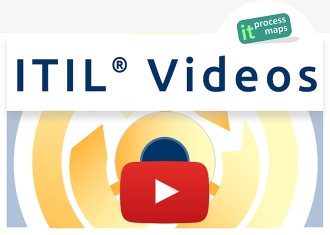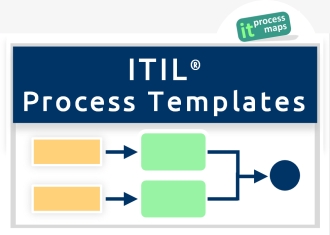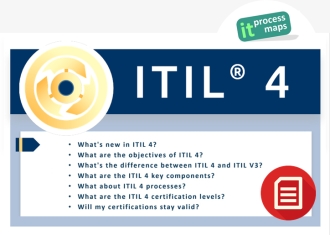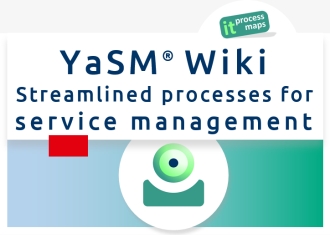Switching from ITIL V2 to ITIL V3: Difference between revisions
New page: The new ITIL V3 books are based very much on the principles known from ITIL V2, but unfortunately there are no detailed instructions for switching to the new set of “[[Comparison between... |
No edit summary |
||
| (2 intermediate revisions by the same user not shown) | |||
| Line 1: | Line 1: | ||
The new ITIL V3 books are based very much on the principles known from ITIL V2, but unfortunately there are no detailed instructions for switching to the new set of | <itpmch><title>Switching from ITIL V2 to ITIL V3 | IT Process Wiki</title> | ||
<meta name="keywords" content="switching itil" /> | |||
<meta name="description" content="How to Achieve the Switch from ITIL V2 to V3. The new ITIL V3 books are based very much on the principles known from ITIL V2, ..." /> | |||
</itpmch> | |||
<imagemap> | |||
Image:ITIL-Wiki-de-es.jpg|right|DE - ES - Switching from ITIL V2 to ITIL V3|163px | |||
rect 81 0 114 36 [https://wiki.de.it-processmaps.com/index.php/Umstieg_von_ITIL_V2_auf_ITIL_V3 diese Seite auf Deutsch] | |||
rect 115 0 163 36 [https://wiki.es.it-processmaps.com/index.php/Cambiando_de_ITIL_V2_a_ITIL_V3 esta página en español] | |||
desc none | |||
</imagemap> | |||
<br style="clear:both;"/> | |||
=== How to Achieve the Switch from ITIL V2 to V3 2007 / ITIL 2011 === | |||
The new ITIL books are based very much on the principles known from ITIL V2, but unfortunately there are no detailed instructions for switching to the new set of "[[Comparison between ITIL V3 and ITIL V2 - The Main Changes#New ITIL Structure: The ITIL V3 Service Lifecycle|Service Lifecycle]]" processes. As a result, the only advice available is a rough outline of a two-step strategy for switching to the new ITIL version: | |||
* Take all existing ITIL processes and plug them into the new Service Lifecycle process structure | * Take all existing ITIL processes and plug them into the new Service Lifecycle process structure | ||
* Benchmark the existing processes against the new ITIL | * Benchmark the existing processes against the new ITIL recommendations and replace, add or improve processes as appropriate | ||
An [[ITIL Implementation with Process Templates# ITIL Reference Process Models|ITIL reference model]], containing a complete ITIL V3 process framework, is able to support switching to the new ITIL version because existing V2 processes can be plugged into the new Service Lifecycle Structure. | An [[ITIL Implementation with Process Templates#ITIL Reference Process Models|ITIL reference model]], containing a complete ITIL V3 or ITIL 2011 process framework, is able to support switching to the new ITIL version because existing V2 processes can be plugged into the new Service Lifecycle Structure. | ||
An overview diagram of Problem Management, for example, presents how this process is interfacing with the other Service Operation processes. This makes it easy to decide where process interfaces must be modified, and any existing documentation on the Problem Management process can be incorporated into this structure. | An overview diagram of Problem Management, for example, presents how this process is interfacing with the other Service Operation processes. This makes it easy to decide where process interfaces must be modified, and any existing documentation on the Problem Management process can be incorporated into this structure. | ||
=== When to Switch === | |||
Because the new ITIL books are based very much on the principles known from ITIL V2, there is no urgent need for action for any IT organization with ITIL V2 processes in operation. But you might want to look at ITIL V3 or ITIL 2011 to see if it offers any hints about where to improve your processes. | |||
In the longer term, however, there will only be "one version of ITIL" - at least for a few years. This means that even in cases where the processes itself do not need to be changed, at one point in time a switch to the service lifecycle process structure will have to be made. Such an alignment also offers the chance to benefit from the improvements of the ITIL V3 version. | |||
* [[Comparison between ITIL V3 and ITIL V2 - The Main Changes# Comparison and Changes between ITIL V3 and ITIL V2 in Detail|Comparison of ITIL V2 and ITIL V3]] | |||
* [[ITIL 2011|The main changes and differences between ITIL V3 2007 and ITIL 2011]] | |||
<p> </p> | |||
''' Back to: ''' | |||
→ '''[[ITIL Implementation|ITIL Implementation - ITIL Implementation in 10 Steps]]''' | |||
<p> </p> | |||
<!-- This page is assigned to the following categories: --> | |||
[[Category:ITIL version]][[Category:ITIL process]] | |||
<!-- --- --> | |||
Latest revision as of 10:39, 28 April 2017

How to Achieve the Switch from ITIL V2 to V3 2007 / ITIL 2011
The new ITIL books are based very much on the principles known from ITIL V2, but unfortunately there are no detailed instructions for switching to the new set of "Service Lifecycle" processes. As a result, the only advice available is a rough outline of a two-step strategy for switching to the new ITIL version:
- Take all existing ITIL processes and plug them into the new Service Lifecycle process structure
- Benchmark the existing processes against the new ITIL recommendations and replace, add or improve processes as appropriate
An ITIL reference model, containing a complete ITIL V3 or ITIL 2011 process framework, is able to support switching to the new ITIL version because existing V2 processes can be plugged into the new Service Lifecycle Structure.
An overview diagram of Problem Management, for example, presents how this process is interfacing with the other Service Operation processes. This makes it easy to decide where process interfaces must be modified, and any existing documentation on the Problem Management process can be incorporated into this structure.
When to Switch
Because the new ITIL books are based very much on the principles known from ITIL V2, there is no urgent need for action for any IT organization with ITIL V2 processes in operation. But you might want to look at ITIL V3 or ITIL 2011 to see if it offers any hints about where to improve your processes.
In the longer term, however, there will only be "one version of ITIL" - at least for a few years. This means that even in cases where the processes itself do not need to be changed, at one point in time a switch to the service lifecycle process structure will have to be made. Such an alignment also offers the chance to benefit from the improvements of the ITIL V3 version.
- Comparison of ITIL V2 and ITIL V3
- The main changes and differences between ITIL V3 2007 and ITIL 2011
Back to:
→ ITIL Implementation - ITIL Implementation in 10 Steps






